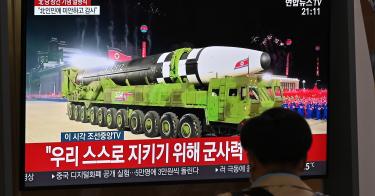The International Atomic Energy Agency recently assessed that North Korea resumed operations at its Yongbyon nuclear reactor, which produces plutonium for nuclear weapons.
Pyongyang also may have reprocessed nuclear fuel from previous reactor operations. The developments are worrisome and will test the Biden administration on how to respond to North Korea expanding its ongoing production of nuclear weapons material.
In recent years, North Korea has expanded and refined manufacturing facilities for fissile material, nuclear weapons, missiles, mobile missile launchers, and reentry vehicles.
In 2017, the U.S. intelligence community assessed that North Korea had between 30 and 60 nuclear weapons (or weapons’ worth of fissile material) and could annually produce an additional seven to 12 weapons.
While the Yongbyon reactor was offline, production would have decreased; however, resumed reactor operations will presumably return nuclear production to 2017-2018 levels.
Since 2017, North Korea demonstrated significant improvements in its ability to target South Korea, Japan, and the continental United States with nuclear weapons. That year, Pyongyang conducted three ICBM test-launches, as well as a hydrogen (thermonuclear) weapon explosion at least 10 times as powerful as the Hiroshima and Nagasaki bombs.
North Korea is now producing a new generation of advanced mobile missiles that are more accurate and more difficult to detect and target, and have an enhanced ability to evade allied missile defenses.
In 2019, Pyongyang conducted 26 missile launches, all of them violations of U.N. resolutions and more than it had ever tested in a year.
In October, Pyongyang unveiled the Hwasong-16 ICBM, the world’s largest mobile missile on a launch vehicle. The missile, larger than North Korea’s previous ICBM models, may be capable of carrying three or four nuclear warheads.
Pyongyang also revealed that it can produce mobile ICBM transporter-erector-launchers. The regime’s ability to deploy more ICBM missiles with multiple warheads on mobile launchers risks overwhelming limited U.S. missile defenses protecting the American homeland.
In January, North Korean leader Kim Jong Un lauded his scientists for developing miniaturized nuclear weapons from tactical warheads to a super-large thermonuclear hydrogen bomb as well as more accurate guidance technology for ICBMs.
He announced that North Korea was developing the ability to deploy multiple warheads on a solid-fueled ICBM and a nuclear-powered submarine to launch intercontinental strategic weapons.
North Korea declared it would improve the quality and quantity of its nuclear forces, recently vowing to “bolster the national defensive power and preemptive strike capabilities, which can strongly contain and eliminate the outside threats.”
Pyongyang has repeatedly vowed to take escalatory, though unspecified, actions while blaming U.S. or South Korean actions as being the catalyst.
North Korea typically engages in major action during the first year of new U.S. and South Korean administrations, since the regime thinks it provides negotiating leverage. But Pyongyang has refrained so far this year, perhaps because it faces internal challenges and COVID-19 precludes North Korean diplomats from meeting with U.S. counterparts.
Washington should continue diplomatic efforts to denuclearize North Korea despite the failure of all previous international agreements. Negotiations with Pyongyang have stalled since 2019, and the regime has rejected all U.S. and South Korean attempts to resume dialogue.
As such, the United States and its allies must concurrently implement measures to enhance deterrence and defense capabilities.
Diplomacy and deterrence are not mutually exclusive. North Korea is unlikely to intimidate or attack South Korea if it perceives that the U.S.-South Korean alliance is strong and that the U.S. commitment to defend South Korea is beyond doubt.
The U.S. should make absolutely clear to friend and foe alike that it will defend its allies and maintain current levels of U.S. forces until the North Korean nuclear, missile, and conventional force threats have been sufficiently reduced.
Deterrence consists of credible commitments as well as capabilities, including strategic and theater missile defenses and strong U.S. forces in the Indo-Pacific region.
This piece originally appeared in The Daily Signal



